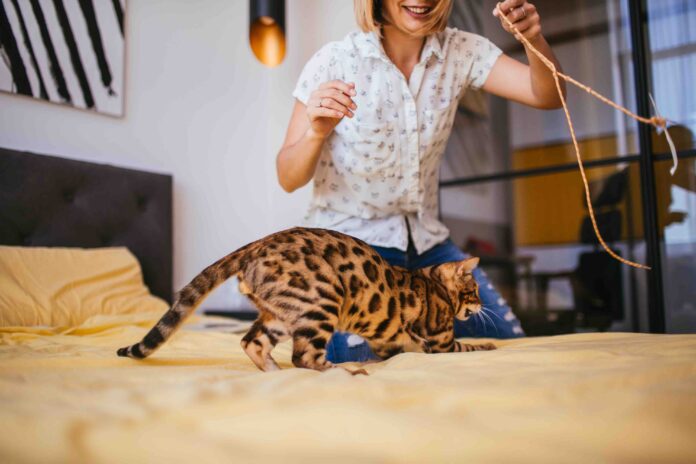The Benefits of Cat Training and Positive Reinforcement
Cat training is often seen as a daunting task for many cat owners. However, it’s important to understand that training your feline companion can have numerous benefits that can positively impact both you and your pet. Cats are intelligent animals with a natural instinct to hunt, play, and explore their surroundings.
By teaching them good behavior and fun tricks, you can provide them with mental stimulation and prevent boredom. One of the biggest advantages of cat training is that it allows you to develop a stronger bond with your furry friend.
A well-trained cat is more likely to feel comfortable around people, other pets, and new environments. This means less anxious behaviors like hiding under the bed or hissing at strangers.
As a result, you’ll be able to enjoy more quality time with your kitty without worrying about any negative behaviors. Positive reinforcement is an essential part of cat training that should never be overlooked or skipped over.
It involves rewarding good behavior instead of punishing bad behavior. This technique has been scientifically proven to be highly effective in animal training because it encourages cats to repeat desirable actions voluntarily rather than being forced into obedience through fear or intimidation.
By using positive reinforcement in conjunction with clicker training or treats, you can make learning new commands and tricks fun for your cat as well as rewarding for both of you! So don’t be afraid to give it a try – teaching your cat good behavior isn’t just beneficial but an enjoyable experience too!
Understanding Your Cat’s Behavior
Basic Feline Instincts and Behavior Patterns
To understand your cat’s behavior, it helps to know some of their basic instincts and patterns. Cats are natural predators, so they tend to be hunters by nature.
This means that they may stalk, pounce, and play with toys or other objects like they would with prey in the wild. Cats are also creatures of habit and enjoy routine.
They tend to sleep for long periods during the day and be more active at night when their prey would typically be active. Cats use body language to communicate their mood or intentions with others.
For example, a cat that is feeling aggressive may puff up their fur and arch their back as a sign of aggression or fear. They also use vocalizations like meowing, purring, and hissing to communicate with humans or other animals.
Recognizing Signs of Stress and Anxiety in Cats
Cats can become stressed or anxious for a variety of reasons including changes in routine, new people or animals in the household, or even illness. It is important to recognize the signs of stress so you can address them before they become more serious problems.
Some symptoms of stress in cats include hiding more than usual, decreased appetite, excessive grooming (which can lead to hair loss), changes in litter box habits (such as avoiding the litter box), increased vocalization (meowing), or aggressive behavior. If you notice any of these signs in your cat it is important to identify any changes that may have triggered them such as new people or animals in the household.
If you can identify what is causing your cat’s stress then addressing that issue will help alleviate your cat’s anxiety. understanding your cat’s instinctual behavior patterns will help owners redirect unwanted behaviors while recognizing when cats’ behaviors indicate something else like stress or anxiety will lead to better care.
Litter Box Training: Making Life Easier for You and Your Cat
Choosing the Right Litter Box and Litter Type
Choosing the right litter box is essential to your cat’s comfort and success with litter box training. The box should be large enough for your cat to comfortably turn around in, and ideally, it should have high sides to prevent litter from spilling out.
Covered boxes can provide additional privacy for your cat but may not work well if you have a large or elderly cat who may have difficulty getting in and out of the box. Selecting the right type of litter is just as important as choosing the right litter box.
Most cats prefer unscented clumping clay litters, but there are also other types available, such as recycled paper or wood chips. It’s best to experiment with different types of litters until you find one that your cat likes.
Teaching Your Cat to Use the Litter Box Consistently
Cats are naturally fastidious animals, so using a litter box should come naturally to them. However, it’s still important to properly train them so they understand where they are supposed to go. To start training your cat, place them in the litter box after meals or when they wake up from a nap – these are typically times when cats need to go potty.
Give them some time alone in the room so they can explore and get comfortable with their new surroundings. If you catch your cat starting to use another area of the house as their bathroom spot, quickly pick them up and bring them over to their designated litter box location while saying “no” firmly but gently.
With repeated training sessions like this paired with positive reinforcement once they do use the litterbox correctly, eventually using it will become second nature for your feline friend! Remember that patience is key when it comes to litter box training.
Be consistent with your training and make sure to reward your cat when they use the litter box correctly. Over time, your cat will develop a routine of using the litter box and you’ll both enjoy a cleaner, more pleasant living environment!
Teaching Good Behavior
Why Positive Reinforcement is Key
When it comes to training your cat, positive reinforcement is the most effective method. Punishing your cat for bad behavior may get them to stop temporarily, but it can damage your relationship with them in the long run.
Positive reinforcement means rewarding your cat for good behavior with treats, playtime or affection. This will encourage your cat to repeat the desired behaviour in order to earn more rewards.
Addressing Common Behavioral Issues
Scratching furniture and jumping on counters are two of the most common behavioral issues that cat owners face. Luckily, there are ways to address these issues without resorting to punishment. For scratching furniture, provide plenty of appropriate scratching posts and toys, and discourage scratching on furniture by using double-sided tape or motion-activated deterrents.
Jumping on counters can be discouraged by providing alternative high-up spaces for your cat, such as a tall cat tree or shelves. You can also use deterrents such as aluminum foil or sticky tape on counter surfaces.
The Power of Consistency
Consistency is crucial when training your cat. If you let them get away with bad behavior sometimes but punish them other times, they will become confused about what is expected of them. Make sure everyone in the household follows the same rules and uses the same training methods so that your cat receives consistent messages.
Remember that every cat is different and may require different approaches when it comes to training. Be patient and persistent and don’t give up if you don’t see results immediately – cats are intelligent animals who respond well to positive reinforcement over time!
Fun Tricks to Teach Your Cat
Your cat is not only capable of learning basic good behavior, but they can also learn some fun tricks too! These tricks can provide mental stimulation for your cat, strengthen your bond with them, and even impress your friends. Here are a few simple and advanced tricks you can teach your feline friend:
Simple Tricks: Sit, Shake, and High Five
Teaching your cat to sit is a great foundation trick for more advanced commands. Hold a treat close to their nose and move it slowly upward towards their head as you say “sit.” As their head moves up with the treat, their bottom should naturally lower. As soon as they are in the sitting position, give them the treat and plenty of praise.
Repeat this several times until they start sitting without you holding the treat. For shake or high five, hold out a hand close to your cat’s paw and say “shake” or “high five” while gently tapping their paw.
When they move their paw in response, reward them with a treat and praise. Practice this regularly until they start offering their paw on command.
More Advanced Tricks: Playing Dead or Fetching
Teaching more advanced tricks like playing dead or fetching requires patience and dedication but can be extremely rewarding once mastered. For playing dead, start by training them to lie down on command (using the same method as teaching sit) then hold out a treat in front of their nose before slowly lowering it down towards the ground while saying “bang” or “play dead.” Once they lay down completely still with the treat in front of them, give them the reward. To teach your cat how to fetch like a dog would require using toys instead of treats.
Start by tossing a favorite toy near them and when they go after it offer praise before holding out another toy so that when they return with the first toy, they can trade it for the second one. Slowly increase the distance between you and your cat to make it more challenging.
By teaching your cat simple and advanced tricks, you will not only improve their mental stimulation but also strengthen your relationship with them. Remember to always practice patience, use positive reinforcement, and have fun while teaching your furry friend new tricks.
Training Tools and Techniques
Your cat is a smart animal that can learn almost any behavior with the right training tools and techniques. Positive reinforcement is the most effective way to train your furry friend, and here are some popular training tools and techniques you can use to teach your cat good behavior.
Clicker Training
Clicker training is a popular method of positive reinforcement that uses a clicker device to signal success to your cat. Clicker training involves clicking the device when your cat performs a desired behavior, immediately followed by giving them a treat. Over time, your cat will start associating the click with good behavior, making it easier for them to learn new tricks.
To start clicker training, get a clicker device at your local pet store. Begin by teaching your cat that the sound of the click means they did something good by clicking and then rewarding them with treats immediately after.
Then move on to using the click when they perform specific behaviors. Remember to keep sessions short and consistent.
Treats and Rewards
Treats are an excellent tool for reinforcing positive behavior in cats because they’re tasty and provide instant gratification. Use small pieces of their favorite food as rewards for performing good behaviors like using their litter box or responding well during playtime. It’s important not to overdo it with treats, though.
Too much of anything can be harmful, so stick to small reward amounts throughout each session. You can also try varying treat types or flavors periodically so that your cat doesn’t get bored.
Harness Training for Outdoor Adventures
Harness training is essential if you want to take your feline friend outdoors safely while preventing them from running off away from you or getting hurt in any way possible outdoors.However, harnesses are not always easy for cats who aren’t used to wearing collars or having anything placed over their backs. To start training, introduce your cat to the harness first by leaving it in their space for a few days. Once they’re used to seeing it, start putting the harness on and off while giving them treats each time it’s on.
Practice with the leash indoors before venturing outdoors, going slowly and letting your cat explore at their own pace. And there you have it!
With these training tools and techniques, you can set your cat up for success and teach them good behavior while having fun in the process. Remember to be patient with your furry friend and keep sessions short to avoid frustration or boredom.
Conclusion
Recap of Key Points
Training your cat may seem like a daunting task, but it’s essential for establishing a happy and healthy relationship with your feline companion. In this article, we covered the basics of cat behavior and training techniques to address behavioral issues and teach fun tricks.
We discussed the importance of understanding your cat’s instincts and behavior patterns to recognize signs of stress and anxiety. We also covered litter box training, using positive reinforcement for good behavior, and tools like clicker training and treats.
Teaching your cat fun tricks can be a great way to bond with them and provide mental stimulation. We provided examples of simple tricks such as sit, shake, high five, as well as more advanced ones like playing dead or fetching.
Encouragement to Continue Training Your Cat
Remember that patience is key when training your cat. It takes time for them to learn new behaviors and tricks.
But the rewards are worth it – a well-trained cat is less likely to engage in destructive behavior or become stressed or anxious. So keep up with the training!
Make it a part of your daily routine with your furry friend. And don’t forget to have fun – training should be enjoyable for both you and your cat.
With dedication and perseverance, you can establish a strong bond with your feline companion through positive reinforcement-based training techniques. Good luck on this exciting journey!



